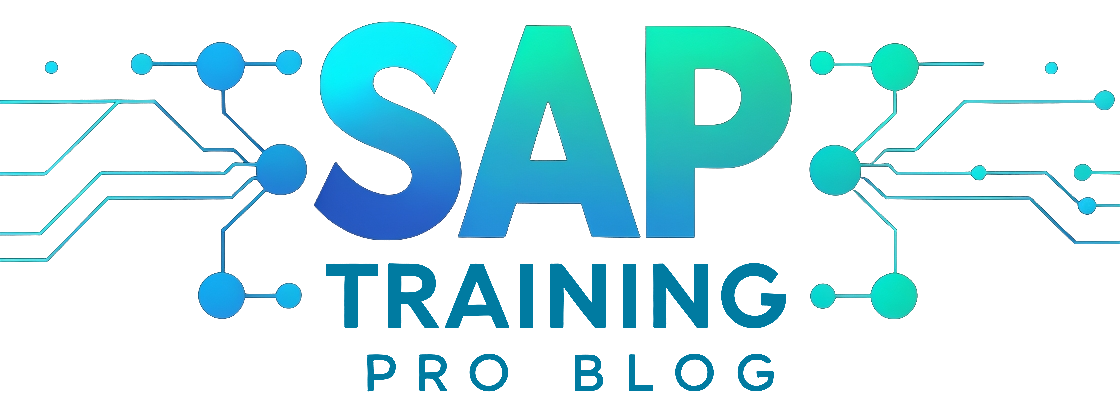Harness the Power of SAP Training for HR Professionals

Are you an HR professional looking to take your skills to the next level? Look no further than SAP training. SAP, which stands for Systems, Applications, and Products, is a powerful software that can revolutionize the way you manage human resources. With SAP training, you can harness this power and enhance your abilities in managing HR effectively.
Table Of Content
So, what exactly can SAP training do for you? Well, it offers a wide range of benefits. Firstly, it improves data management. With SAP, you can gather, analyze, and utilize HR data more effectively, leading to better insights and informed decision-making. Secondly, it streamlines HR processes. SAP can automate and simplify tasks, reducing manual work and allowing you to focus on strategic initiatives. Lastly, it enhances your overall HR operations. From recruitment to performance management, SAP can optimize various HR processes, making them more efficient and effective.
By acquiring SAP skills through training programs and certifications, you can boost your career prospects and contribute to the success of your organization. So, why wait? Discover the power of SAP training for HR professionals and unlock your full potential.
Understanding SAP for HR
Understanding SAP for HR
SAP, which stands for Systems, Applications, and Products in Data Processing, is a powerful software solution that can revolutionize the way HR professionals manage human resources. By harnessing the power of SAP, HR departments can streamline their processes, improve data management, and enhance decision-making capabilities.
SAP offers a comprehensive suite of modules specifically designed for HR processes, including recruitment, onboarding, performance management, and employee development. These modules provide a centralized platform for HR professionals to efficiently manage and track employee data, streamline workflows, and automate manual tasks.
With SAP, HR professionals can gather, analyze, and utilize data effectively, leading to better insights and informed decision-making. The software enables them to access real-time information, generate reports, and identify trends and patterns that can drive strategic HR initiatives.
By understanding the basics of SAP and its potential applications in HR, professionals can unlock a world of possibilities to enhance their efficiency, productivity, and overall effectiveness in managing human resources.
The Benefits of SAP Training
When it comes to HR professionals, SAP training offers a range of benefits that can greatly enhance their skills and capabilities. One of the key advantages of SAP training is improved data management. With SAP, HR professionals can efficiently gather, analyze, and utilize data, leading to better insights and informed decision-making. This enables them to make strategic HR decisions based on accurate and up-to-date information.
In addition to improved data management, SAP training also helps streamline HR processes. By automating and simplifying tasks, SAP reduces manual work and allows HR professionals to focus on more strategic initiatives. This not only saves time and resources but also ensures that HR processes are executed efficiently and effectively.
Furthermore, SAP training enhances decision-making capabilities. With access to real-time data and advanced analytics, HR professionals can make data-driven decisions that align with organizational goals. This enables them to optimize HR operations, improve employee satisfaction, and contribute to the overall success of the organization.
Enhancing HR Operations with SAP
Enhancing HR Operations with SAP
Discover how SAP can optimize HR operations and revolutionize the way HR professionals manage various aspects of human resources. SAP offers a range of solutions that can streamline and automate key HR processes, including recruitment, onboarding, performance management, and employee development.
With SAP, HR professionals can efficiently manage the entire recruitment process, from posting job vacancies to screening candidates and conducting interviews. The system can automate repetitive tasks, such as resume parsing and applicant tracking, saving valuable time and effort. SAP also provides comprehensive onboarding tools that ensure a smooth transition for new employees, enabling them to quickly integrate into the organization.
Furthermore, SAP offers robust performance management capabilities, allowing HR professionals to set goals, track progress, and provide feedback to employees. The system enables the creation of performance metrics and generates insightful reports, facilitating data-driven decision-making. Additionally, SAP supports employee development by providing learning management tools and personalized training plans.
In summary, SAP empowers HR professionals to optimize their operations, improve efficiency, and enhance employee satisfaction. By leveraging the power of SAP, HR departments can transform their processes and contribute to the overall success of the organization.
Streamlining HR Processes
Discover how SAP can revolutionize HR processes by automating and simplifying tasks, ultimately reducing the burden of manual work on HR professionals. With SAP, repetitive and time-consuming tasks such as data entry, document management, and payroll processing can be streamlined, allowing HR teams to allocate their valuable time and resources towards strategic initiatives that drive organizational success.
SAP’s robust automation capabilities enable HR professionals to optimize various processes, including recruitment, onboarding, performance management, and employee development. By automating these tasks, SAP eliminates the need for manual intervention, minimizing errors and ensuring consistent and efficient workflows. This not only saves time but also enhances accuracy, ensuring that HR professionals can make informed decisions based on reliable data.
Furthermore, SAP’s user-friendly interface and intuitive features make it easy for HR professionals to navigate and utilize the system effectively. With simplified processes, HR teams can focus on building strong relationships with employees, fostering a positive work culture, and developing strategies to attract and retain top talent. By leveraging SAP’s automation capabilities, HR professionals can transform their role from administrative support to strategic business partners, contributing significantly to the overall success of the organization.
Effective Data Management
SAP offers HR professionals a powerful tool for effective data management. With SAP, HR professionals can gather, analyze, and utilize data in a way that leads to better insights and informed decision-making.
One of the key benefits of SAP is its ability to centralize and integrate data from various HR processes. This means that HR professionals can access all relevant data from a single platform, making it easier to track and manage employee information, performance metrics, and other HR-related data points. By having a comprehensive view of the data, HR professionals can make more informed decisions and develop strategies that align with the organization’s goals.
SAP also enables HR professionals to analyze data in real-time, providing them with up-to-date information on key HR metrics. This allows for proactive decision-making and the ability to identify trends and patterns that can help improve HR processes and drive organizational success. Additionally, SAP’s reporting capabilities enable HR professionals to generate customized reports and dashboards, making it easier to present data to stakeholders and communicate key insights effectively.
In summary, SAP empowers HR professionals with effective data management tools, enabling them to gather, analyze, and utilize data in a way that leads to better insights and informed decision-making. By harnessing the power of SAP, HR professionals can optimize their HR processes and contribute to the overall success of their organization.
Developing SAP Skills for HR Professionals
Are you an HR professional looking to enhance your career prospects and contribute to organizational success? Look no further than acquiring SAP skills through training programs and certifications. SAP, the leading enterprise resource planning software, offers a range of courses specifically designed for HR professionals.
By participating in SAP training programs, HR professionals can gain in-depth knowledge of SAP modules relevant to human resources management. These modules cover various aspects, including recruitment, onboarding, performance management, and employee development. Through hands-on training and practical exercises, HR professionals can develop the skills needed to effectively utilize SAP in their daily operations.
Furthermore, obtaining SAP certifications can significantly boost your credentials and demonstrate your expertise in SAP HR modules. These certifications validate your knowledge and proficiency in utilizing SAP for HR processes. Employers often prioritize candidates with SAP certifications, as it indicates their commitment to continuous learning and staying updated with the latest industry trends.
By developing SAP skills, HR professionals can not only enhance their career prospects but also contribute to organizational success. With SAP’s powerful tools and functionalities, HR professionals can streamline processes, improve data management, and make informed decisions. So why wait? Start your journey to becoming an SAP-savvy HR professional today!
Implementing SAP in HR Departments
Implementing SAP in HR departments requires careful planning and execution to ensure a successful transition and maximize the benefits of the software. To achieve this, organizations should follow best practices that focus on change management strategies, stakeholder engagement, and ensuring user adoption.
Change management strategies play a crucial role in the successful implementation of SAP in HR departments. It is important to communicate the purpose and benefits of SAP to all stakeholders and address any concerns or resistance that may arise. By involving employees in the process and providing training and support, organizations can minimize disruption and facilitate a smooth transition.
Stakeholder engagement is another key aspect of implementing SAP in HR departments. Engaging HR teams, employees, and management in the decision-making process and keeping them informed about the implementation progress can help build trust and ensure their buy-in and support. Regular communication and feedback channels should be established to address any issues or questions that may arise.
Ensuring user adoption is essential for the successful implementation of SAP in HR departments. Training programs should be designed to equip HR professionals with the necessary skills and knowledge to effectively use the software. User-friendly interfaces and ongoing support should also be provided to encourage adoption and maximize the benefits of SAP.
By following these best practices, organizations can harness the power of SAP in their HR departments, streamline processes, and improve overall efficiency and productivity.
Change Management Strategies
Implementing SAP in HR departments can bring about significant changes in the way human resources are managed within an organization. However, change can often be met with resistance and challenges. To ensure a smooth transition and minimize resistance, effective change management strategies are essential.
One of the key strategies is effective communication. It is crucial to clearly communicate the reasons for implementing SAP and how it will benefit the HR department and the organization as a whole. This can be done through regular meetings, presentations, and training sessions. By keeping all stakeholders informed and engaged, resistance can be minimized, and a sense of ownership and excitement can be fostered.
Another important strategy is involving employees in the change process. By including HR staff in the decision-making and implementation stages, they feel valued and empowered. This involvement can be achieved through workshops, focus groups, and feedback sessions. By actively involving employees, their concerns and suggestions can be addressed, leading to a smoother transition and higher levels of acceptance.
Additionally, providing comprehensive training and support is crucial for successful change management. HR professionals need to be equipped with the necessary skills and knowledge to effectively use SAP. Training programs, workshops, and online resources can be utilized to ensure that employees are well-prepared and confident in using the new system.
In conclusion, effective change management strategies are vital when implementing SAP in HR departments. By communicating effectively, involving employees, and providing comprehensive training, organizations can ensure smooth transitions, minimize resistance, and maximize the benefits of SAP in managing human resources effectively.
Engaging Stakeholders
Engaging stakeholders is crucial for the successful implementation of SAP in HR departments. It is important to ensure that HR teams, employees, and management are fully on board and supportive of the SAP implementation process. Here are some strategies to engage stakeholders:
- Communication: Open and transparent communication is key to engaging stakeholders. Regularly communicate the benefits and goals of implementing SAP, addressing any concerns or questions they may have.
- Training and Education: Provide comprehensive training and education to stakeholders to familiarize them with SAP and its benefits. This will help them understand the value it brings to HR processes and encourage their buy-in.
- Involvement: Involve stakeholders in the decision-making process and seek their input. This will make them feel valued and increase their sense of ownership in the SAP implementation.
- Addressing Concerns: Actively listen to stakeholders’ concerns and address them promptly. This will help alleviate any resistance or skepticism they may have towards the new system.
- Continuous Support: Provide ongoing support and assistance to stakeholders throughout the SAP implementation process. This can include dedicated help desks, training sessions, and resources to ensure a smooth transition.
By engaging stakeholders effectively, HR professionals can ensure their support and cooperation, leading to a successful SAP implementation that enhances HR processes and drives organizational success.

